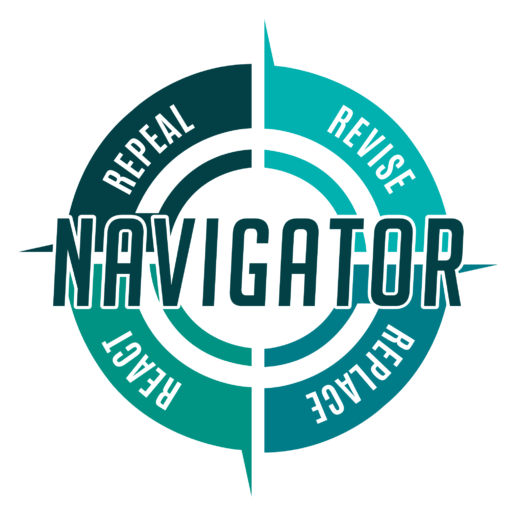Under the ACA:
Proposed under the AHCA:
- Establish a state based health insurance exchange and provide oversight of health plans with regard to the new insurance market regulations, consumer protections, rate reviews, solvency, reserve fund requirements, premium taxes, and to define rating areas.
- Establish an office of health insurance consumer assistance or an ombudsman program to serve as an advocate for residents who are uninsured or covered under any private coverage and to help consumers appeal denied claims
- Permit states to create a Basic Health Plan for uninsured individuals with incomes between 138% and 200% FPL in lieu of these individuals receiving premium subsidies to purchase coverage in the exchanges.
- Permit states to obtain a five-year waiver of certain new health insurance requirements if the state can demonstrate that it provides health coverage to all residents that is at least as comprehensive as the coverage required under an Exchange plan and that the state plan does not increase the federal budget deficit
Source: kff.org
- States may determine age rating ratio; otherwise federal standard of 5:1 applies.
- Establish new Patient and State Stability Fund. Funds can be used by states for financial help for high-risk individuals, to stabilize private insurance premiums, promote access to preventive services, provide cost sharing subsidies, for maternity coverage and newborn care, for mental health and substance use disorder services, and for other purposes. In states that do not successfully apply for grants, funds will be used for a default reinsurance program, administered by CMS, that will pay 75% of claims between $50,000 and 350,000 (starting in 2020, CMS Administrator can establish different reinsurance rate and claims thresholds.)
- Funding available through the Patient and State Stability Fund includes:
- $100 billion over 9 years ($15 billion per year for 2018-2019, $10 billion per year for 2020-2026) for grants to states or for default reinsurance program;
- $15 billion for a new Federal Invisible Risk Sharing Program (see below);
- $8 billion over 5 years (2018-2023) for states that elect community rating waivers (see below) to provide financial assistance to people whose premiums are surcharged based on health status under that waiver;
- $15 billion for the year 2020 to be used solely for maternity coverage and newborn care and mental health and substance use disorders.
- State matching funding of 7% required in 2020, phasing up to 50% in 2026. A different state matching schedule applies for the CMS-administered default reinsurance program (10% in 2020, phasing up to 50% in 2024.) Grants cannot be made to a state unless it agrees to make matching funds available. Any remaining funds at year end will be re-allocated to the Federal Invisible Risk Sharing Program.
- State option to establish a state based health insurance exchange remains, but premium subsidies are also available for plans sold outside of exchanges, effective January 1, 2018.
- As part of the Patient and State Stability Fund, establish a new “Federal Invisible Risk Sharing Program,” (FIRSP) funded at $15 billion over 9 years, plus any other unallocated funds under the Patient and State Stability Fund. State application and matching funding does not appear to be required for FIRSP. CMS will operate FIRSP for first two years and establish a process for States to operate beginning in 2020.
- Establish new state waiver authority under Public Health Service Act section 2701. Summary of the American Health Care Act 9
- Starting in 2018 states may apply for waivers to permit age rating ratios higher than 5:1 (note, elsewhere, the bill permits states to adopt any age rating ratio they want)
- Starting in 2020, states may apply for waivers to redefine essential health benefits for health insurance coverage offered in the individual and small group market
- Starting in 2019, or for SEP enrollments in 2018, states that use Patient and State Stability Fund grants to establish high-risk pools or reinsurance programs, or that participate in the FIRSP, may apply for waiver of the ACA community rating requirement. Because CMS will operate FIRSP in all states, all states would appear to be eligible to apply for the community rating waiver. Under the waiver, States could allow insurers to use health status as a rating factor for applicants in the individual market who have not maintained continuous coverage. For these individuals, health status rating could be used instead of the 30% late enrollment penalty. The health status rating would only apply during the “enforcement period” – generally for one entire plan year, or in the case of SEP enrollments, for the remainder of the plan year
- For states electing the community rating waiver, which can be granted for 10 years, then extended, an additional $8 billion in Patient and State Stability grants is allocated over 5 years, 2018-2023. Community rating waiver states may only use this additional allocation to provide assistance to reduce premiums or other out of pocket costs of individuals who are subject to health status rating under the waiver. States are not required to completely offset health status rating surcharges, nor are they required to establish high-risk pools for these individuals.
- State waiver applications would be deemed approved within 60 days of submission unless the Secretary denies the application. Applications must specify how the waiver would achieve at least one of the following goals: reduce average health insurance premiums, increase health coverage enrollment, stabilize the health insurance market, stabilize premiums for people with pre-existing conditions, or increase choice of health plans.
- State waiver programs (to change age rating bands, redefine essential health benefits, or apply health status rating in the individual market) cannot apply with respect to the following ACA provisions
- Waivers may not be applied to health plans offered through CO-OP plans, multi-state plans, or to ACA innovation waivers (Section 1332), Basic Health Plan programs (Section 1331), interstate compact programs (Section 1333).
- In addition, waivers may not apply with respect to Section 1312(d)(3)(D) of ACA, which requires the federal government to provide health benefits to Members of Congress through health plans created under the ACA or offered through Exchanges. Note that separate, self-executing legislation, proposed by Rep. McSally, would eliminate this provision upon enactment of the AHCA
- State consumer assistance/ombudsman program is not changed, and is not funded.
- State option to establish a Basic Health Program (BHP) is retained, though federal subsidy funding that would flow through BHP would be reduced. State option to obtain a five-year waiver of certain ACA health insurance requirements (Section 1332 waiver) is not changed.
- States continue to administer the Medicaid program with Federal matching funds available up to the federal cap with the choice of a per capita cap or block grant for certain populations.
Source: kff.org





